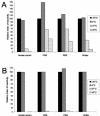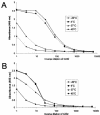Immunoreactivity of cryptococcal antigen is not stable under prolonged incubations in human serum
- PMID: 15184471
- PMCID: PMC427815
- DOI: 10.1128/JCM.42.6.2786-2788.2004
Immunoreactivity of cryptococcal antigen is not stable under prolonged incubations in human serum
Abstract
The stability of cryptococcal antigen from Cryptococcus neoformans serotype A and D strains at different temperatures in serum and other solvents was studied. Samples stored at -20 or 4 degrees C had equivalent stabilities as measured by the Premier Cryptococcal Antigen kit and the Cryptococcal Antigen Latex Agglutination System (CALAS) kit. However, using the Premier Cryptococcal Antigen kit, there was a 91% loss of reactivity in samples incubated in human serum for 4 weeks at 37 degrees C. A loss of reactivity of more than 99% was observed after incubation at 45 degrees C for 4 weeks. The capsular antigen was not detected by the Premier Cryptococcal Antigen kit after 16 weeks at elevated temperatures. Antigen titers were also reduced in a latex agglutination assay (CALAS) after 4 weeks at 37 and 45 degrees C. The loss of antigen reactivity was a function of pH and temperature.
Figures


Similar articles
-
Evaluation of new monoclonal antibody-based latex agglutination test for detection of cryptococcal polysaccharide antigen in serum and cerebrospinal fluid.J Clin Microbiol. 1994 Sep;32(9):2309-11. doi: 10.1128/jcm.32.9.2309-2311.1994. J Clin Microbiol. 1994. PMID: 7814566 Free PMC article.
-
Comparison of the PREMIER cryptococcal antigen enzyme immunoassay and the latex agglutination assay for detection of cryptococcal antigens.J Clin Microbiol. 1991 Aug;29(8):1616-9. doi: 10.1128/jcm.29.8.1616-1619.1991. J Clin Microbiol. 1991. PMID: 1761681 Free PMC article.
-
Effect of potential interference factors on performance of enzyme immunoassay and latex agglutination assay for cryptococcal antigen.J Clin Microbiol. 1994 Sep;32(9):2307-8. doi: 10.1128/jcm.32.9.2307-2308.1994. J Clin Microbiol. 1994. PMID: 7814565 Free PMC article.
-
[Mycological and serological diagnosis of cryptococcosis].Nihon Ishinkin Gakkai Zasshi. 2000;41(4):241-4. doi: 10.3314/jjmm.41.241. Nihon Ishinkin Gakkai Zasshi. 2000. PMID: 11064322 Review. Japanese.
-
Cryptococcal antigen detection in broncho-alveolar lavage fluid.Med Mycol. 2018 Aug 1;56(6):774-777. doi: 10.1093/mmy/myx092. Med Mycol. 2018. PMID: 29087508 Review.
Cited by
-
The Fungal Cell Wall: Structure, Biosynthesis, and Function.Microbiol Spectr. 2017 May;5(3):10.1128/microbiolspec.funk-0035-2016. doi: 10.1128/microbiolspec.FUNK-0035-2016. Microbiol Spectr. 2017. PMID: 28513415 Free PMC article. Review.
-
Capsule structural heterogeneity and antigenic variation in Cryptococcus neoformans.Eukaryot Cell. 2007 Aug;6(8):1464-73. doi: 10.1128/EC.00162-07. Epub 2007 Jun 29. Eukaryot Cell. 2007. PMID: 17601878 Free PMC article.
-
Multiple Disguises for the Same Party: The Concepts of Morphogenesis and Phenotypic Variations in Cryptococcus neoformans.Front Microbiol. 2011 Sep 6;2:181. doi: 10.3389/fmicb.2011.00181. eCollection 2011. Front Microbiol. 2011. PMID: 21922016 Free PMC article.
-
Phase I evaluation of the safety and pharmacokinetics of murine-derived anticryptococcal antibody 18B7 in subjects with treated cryptococcal meningitis.Antimicrob Agents Chemother. 2005 Mar;49(3):952-8. doi: 10.1128/AAC.49.3.952-958.2005. Antimicrob Agents Chemother. 2005. PMID: 15728888 Free PMC article. Clinical Trial.
-
Radial mass density, charge, and epitope distribution in the Cryptococcus neoformans capsule.Eukaryot Cell. 2007 Jan;6(1):95-109. doi: 10.1128/EC.00306-06. Epub 2006 Nov 17. Eukaryot Cell. 2007. PMID: 17114596 Free PMC article.
References
-
- Casadevall, A., J. Mukherjee, S. J. Devi, R. Schneerson, J. B. Robbins, and M. D. Scharff. 1992. Antibodies elicited by a Cryptococcus neoformans-tetanus toxoid conjugate vaccine have the same specificity as those elicited in infection. J. Infect. Dis. 165:1086-1093. - PubMed
-
- Casadevall, A., and J. Perfect. 1998. Cryptococcus neoformans. ASM Press, Washington, D.C.
Publication types
MeSH terms
Substances
Grants and funding
LinkOut - more resources
Full Text Sources

